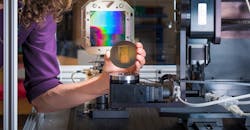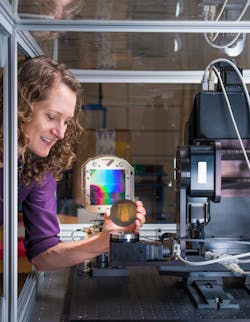Getting X-rays to Image Low-Density Materials
It’s hard to get x-ray images of low-density materials, such as the tissues between bones, because x-rays just pass through like sunlight through a window. But what if you need to see areas that aren’t bone?
Engineers and material scientists at Sandia National Laboratories study a range of low-density materials, from laminate layers in airplane wings to foams and epoxies that cushion parts. So they borrowed and refined a technique being studied in the medical field, x-ray phase contrast imaging, to look inside the softer materials without taking them apart.
X-ray phase contrast imaging measures not just the number of x-ray photons that get through the sample, as in conventional x-ray imaging, but also the phase of the x-rays after they pass through. This offers a complete look at interfaces inside a structure.
In the Sandi device, an optical grating breaks up the x-ray beam into thousands of smaller, very similar x-ray beams. This wave front of beams passes through the object and then through phase and analyzing gratings to an array of detectors. By analyzing the differences between various x-rays that travelled through the object, researchers can reconstruct the paths each took and how dense the various layers or areas are. This gives them a much better view inside the object.
“For low-density materials like plastics, polymers, foams, and other encapsulants, the phase signal can be a thousand times larger than the relatively simple absorption signal of conventional x-rays,” says principal investigator Amber Dagel.
Gratings are critical to the technique, and they can be made to work with higher energy x-rays that will let the researchers peer inside samples that are denser or larger
The research team has been able to spot defects before they could cause catastrophic failures, because materials don’t perform well with voids or cracks or if they’re separating from adjacent surfaces. For example, conventional x-rays can’t see a defect called a grafoil in the laminate layers of an airplane wing without removing the protective copper mesh that diffuses energy if lightning hits the plane. And they can’t see the critically important foams and other materials that guard against shocks, high-voltage breakdowns, and thermal stresses in nuclear weapon components.
“I think it can be useful in research, when you’re trying to understand the distribution of microbeads within an epoxy or how the foam is mating with the canister it’s filling up,” says Dagel. “Is there a gap there? Or what defects can I see in my airplane wing laminate? I also think it can be used in quality assurance to find hidden cracks and voids.”
X-ray phase contrast imaging could also be used to inspect microfabrication packaging, integrated circuits, or micro-electro-mechanical components, as well as to study ceramics, polymers, chemicals, or explosives.



